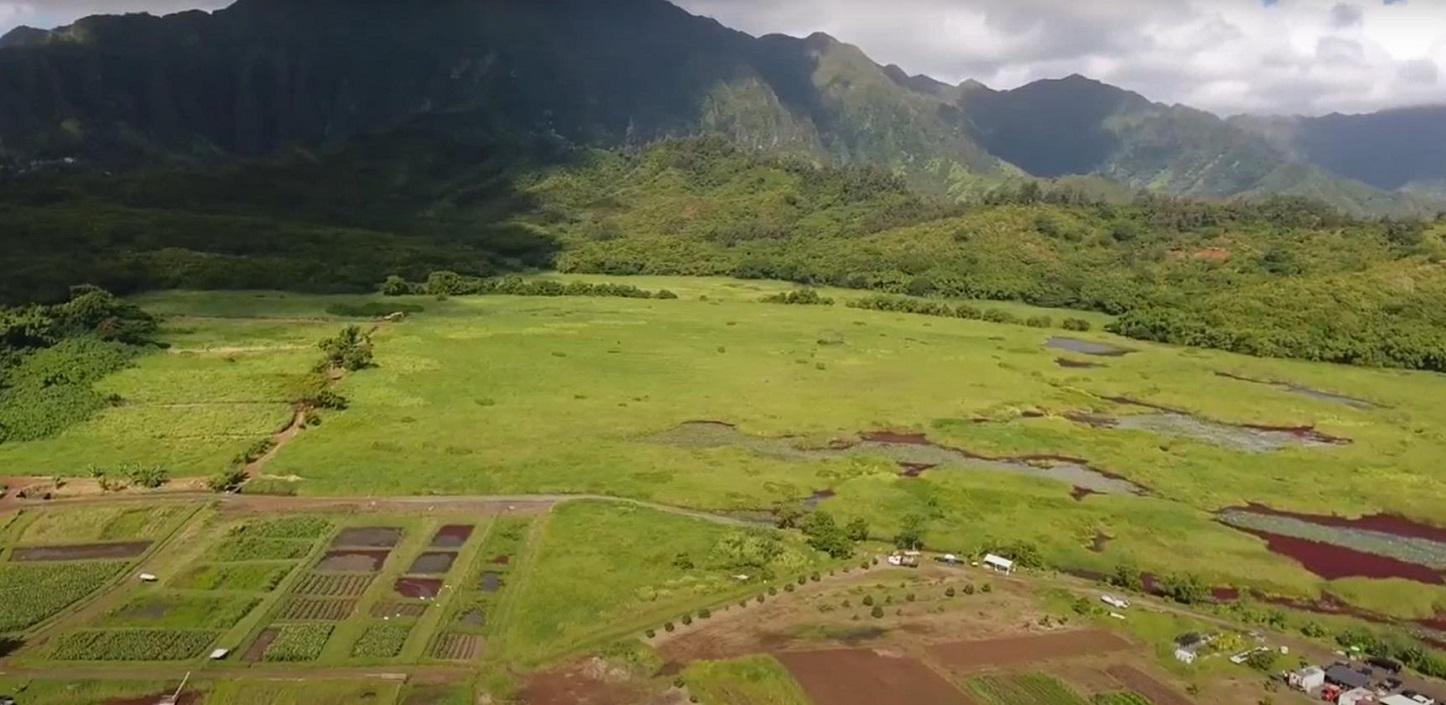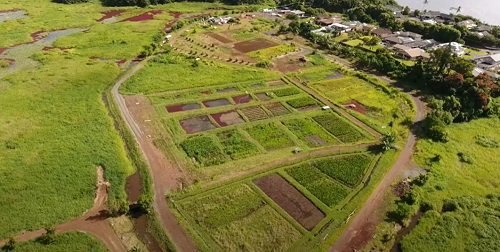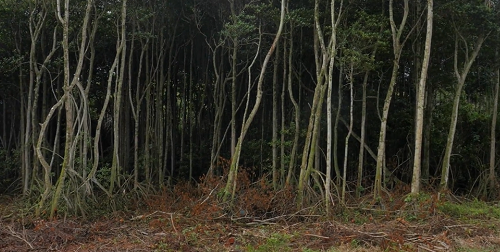
Case Study: The Nature Conservancy
Wetlands Restoration for Ecosystem and Community Resilience in He’eia O’ahu
Table of Contents
- Key Information
- Transferable Strategies
- Project Overview
- Challenges and Solutions
- Print this Case Study
Key Information
| Project Type | Restoration and monitoring | ||
| Theme | Adaptive management and partnerships: To restore function in a degraded but historically, culturally, and ecologically important watershed on O‘ahu’s Eastern Coast, The Nature Conservancy worked closely with local partners and used an adaptive management approach to ensure successful wetland restoration. |
||
| Keywords | Floodplain habitat, fish passage, wetland restoration, stream restoration, traditional knowledge, climate adaptation, partnerships, science, monitoring, sustainable agriculture, local food security | ||
| Organization (Type) | The Nature Conservancy (Nonprofit) | ||
| Project Contacts (as of 2022) |
Kim Falinski, Coastal and Estuarine Scientist, kim.falinski@tnc.org Kristina Jenkins, Hawai‘i Marine Program Manager, kjenkins@tnc.org Kanekoa Kukea Shultz, Executive Director, Kako‘o ‘Ōiwi, admin@kakoooiwi.org |
||
| Award Amount1 and Year | NFWF Award: $768,454 | Match: $768,912 | Award Year: 2018 |
| Location | He‘eia wetlands, Kāne‘ohe Bay, Hawai‘i | ||
| Partners | Kako‘o ‘Ōiwi, He‘eia National Estuarine Research Reserve, the National Oceanic and Atmospheric Administration’s Office for Coastal Management, State of Hawai‘i Division of Aquatic Resources, Hawai‘i Community Development Authority, Paepae o He‘eia, Papahana Kuaola, Ko‘olaupoko Hawaiian Civic Club, University of Hawai‘i | ||
| Multimedia and Additional Links2 |
|
||
1 The award amount does not necessarily reflect the total project cost. The match amount is based on the project proposal information. 2 Disclaimer: The opinions expressed in the multimedia and additional relevant links are those of the project team and their partners only and do not necessarily reflect the views of the National Fish and Wildlife Foundation (NFWF).
Transferable Strategies from this Case Study
- Conduct ongoing monitoring: While monitoring can be costly, designing a project-appropriate and cost-effective monitoring protocol at project outset is a critical step in adaptive management. By having a clear monitoring plan, project teams can be better equipped to understand the impacts of their actions and respond to unexpected changes or roadblocks.
- Build relationships with local partners and technical experts: Prioritizing strong relationships with local organizations and the researchers, government agencies, and technical experts who support the project is essential. Taking the opportunities to gain knowledge and expertise about a project site from those who live and work in the area can be critical in troubleshooting problems and designing adaptive solutions. Local partners can also strengthen support for projects from community members.
Project Overview
|
The Nature Conservancy (TNC) is partnering with community-based nonprofit Kako‘o ‘Ōiwi on a project in the He‘eia wetlands on the windward (eastern) coast of O‘ahu to restore 405 acres of wetlands and promote traditional Hawaiian agricultural practices. The project will reestablish ecological function in an area where historically eight streams converged and connected to the largest bay in the main Hawaiian Islands. The project aims to minimize flood impacts, reduce sediment and nutrient runoff, create healthy habitat and fish passage for marine and estuarine species, and serve as a source of food and clean water for the local community.
Designated as the 29th National Estuarine Research Reserve by the National Oceanic and Atmospheric Administration and listed as a watershed of cultural significance by the Hawai‘i Department of Health, He‘eia remains relatively undeveloped despite past attempts to convert the wetlands for residential use. However, the watershed and surrounding coral reefs have experienced degradation due to the impacts of increasing development and urbanization in surrounding areas. Flooding and storms, which are expected to increase with climate change, have damaged the walls of an ancient fishpond and impacted adjacent corals. Additionally, invasive red mangroves had overtaken the mouth of He‘eia Stream, collecting large amounts of sediment and impeding the passage of larval and juvenile reef fish to the adjacent waters of Kāne‘ohe Bay.
Challenges and Solutions

The He‘eia wetlands once served as important habitat for many native birds, fish, and invertebrates, as well as traditionally managed lo‘i kalo (taro
fields) that produced a primary food source for the surrounding community. Conducting a large-scale restoration project in a culturally and ecologically significant area is not without its challenges, and TNC’s team and partners navigated many complexities during the initial phases of the project. By applying an adaptive management approach and developing productive partnerships with many local organizations, the team is responding to changing circumstances and working productively toward achieving the project’s goals.
Technical and Site Challenges
Challenge:

Though TNC had worked in He‘eia and the surrounding areas prior to this project, the scope of the wetland restoration was much larger than previous efforts. Major project management and technical components, such as removing several acres of overgrown and invasive red mangroves, required more technical expertise and were at a larger scale than projects the team had previously undertaken. The team also implemented an intensive monitoring program to understand the impacts of its restoration interventions. Simultaneously designing and conducting a complex monitoring protocol while undergoing restoration actions in a culturally significant area proved challenging.
Solutions:
- Draw on technical expertise of project partners: Because TNC’s team did not have the technical capacity to complete the mangrove removal, they partnered with Kako‘o ‘Ōiwi, which is leading a long-term project within the He‘eia wetlands to restore traditional agricultural and ecological productivity, grow healthy food for local residents, and promote Hawaiian cultural practices. Kako‘o ‘Ōiwi has equipment, trained operators, and field crews experienced in traditional land management to move the project forward. This partnership enabled the team to complete the mangrove removal and reestablish a functioning loi wa‘i (waterway) system and habitat for native birds, fish, and invertebrates.
- Use monitoring results as an adaptation and communication tool: While challenging to implement, the project team developed a Before-After-Control-Impact (BACI) monitoring approach to quantify the impacts of the restoration activities on water and sediment flow, vegetation, and fish and crustacean populations. Monitoring is an integral component of adaptive management, as it provides information needed to understand how well a project is functioning and adapt actions accordingly. Working closely with research partners at the Heʻeia National Estuarine Research Reserve and the University of Hawaiʻi, the team is collecting vital information that not only helps them manage the project adaptively, but also serves as a template for long-term monitoring. Early monitoring results have already served as an important communication tool for project partners and stakeholders. Specifically, the project team has been able to demonstrate to concerned stakeholders that the restoration efforts are not adversely impacting water quality in the fishpond or bay below the project site.
Project Planning and Coordination
Challenge:

The project brings together a diverse set of partner organizations who have been active in the He‘eia watershed for many years. Working at a large geographic scale with many partners required significant coordination to simultaneously scale restoration activities while also maintaining previously restored areas. Adding to the complexity, the team also had to consider potentially conflicting land use issues, such as allowing for natural water flow while maintaining traditional food production. Balancing the interests of multiple parties and partners required
careful coordination and planning.
Solutions:
- Elevate local and traditional knowledge: This project is part of a decades-long effort led by multiple local land managers, community leaders, and nonprofits active in the project site and adjacent areas. In addition to Kākoʻo ‘Ōiwi, TNC is also collaborating with Paepae o He‘eia, a nonprofit working to maintain the 88-acre ancient He‘eia fishpond. This partnership helped ensure the project was locally and culturally grounded and helped mobilize thousands of volunteers—including school groups, community members, and staff teams from local businesses—who contribute to project implementation by removing weeds, maintaining the taro fields, clearing invasive vegetation, and restoring native plants.
- Adapt to changing project needs: As the project has progressed, the team has managed its organizational composition adaptively to meet emerging needs by collaborating with new experts in areas such as food production and agroforestry. The team has also worked to streamline coordination and adapt team member roles to make the best use of varying expertise and skills.
Print this Case Study (PDF version)